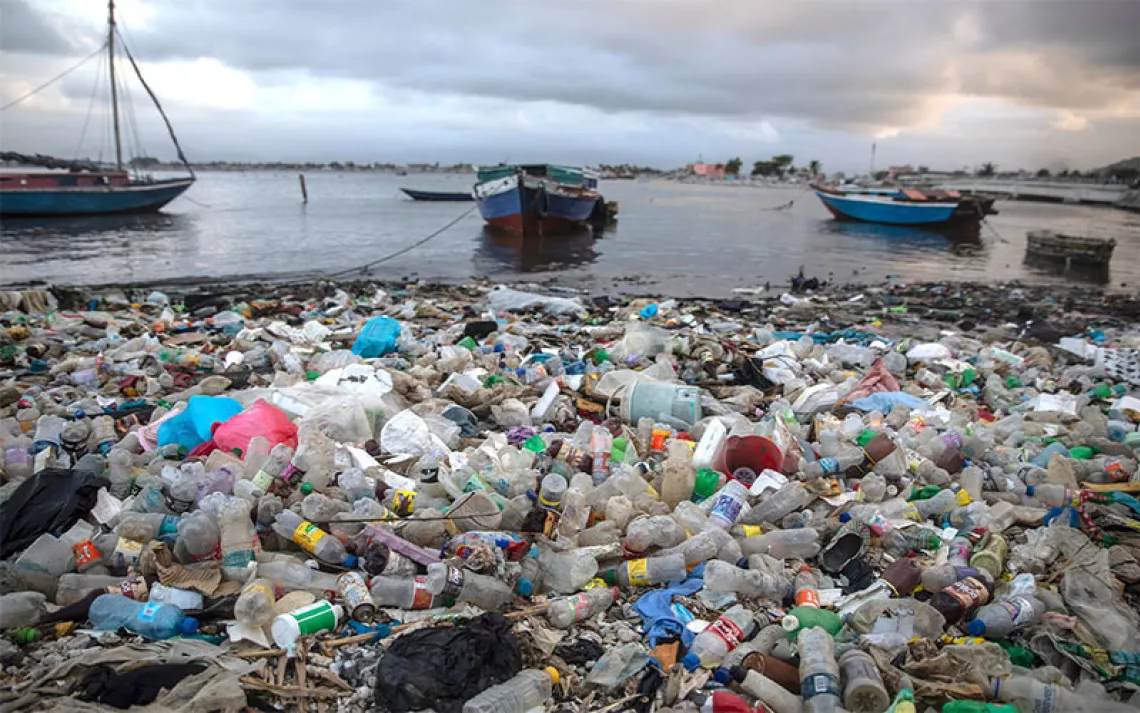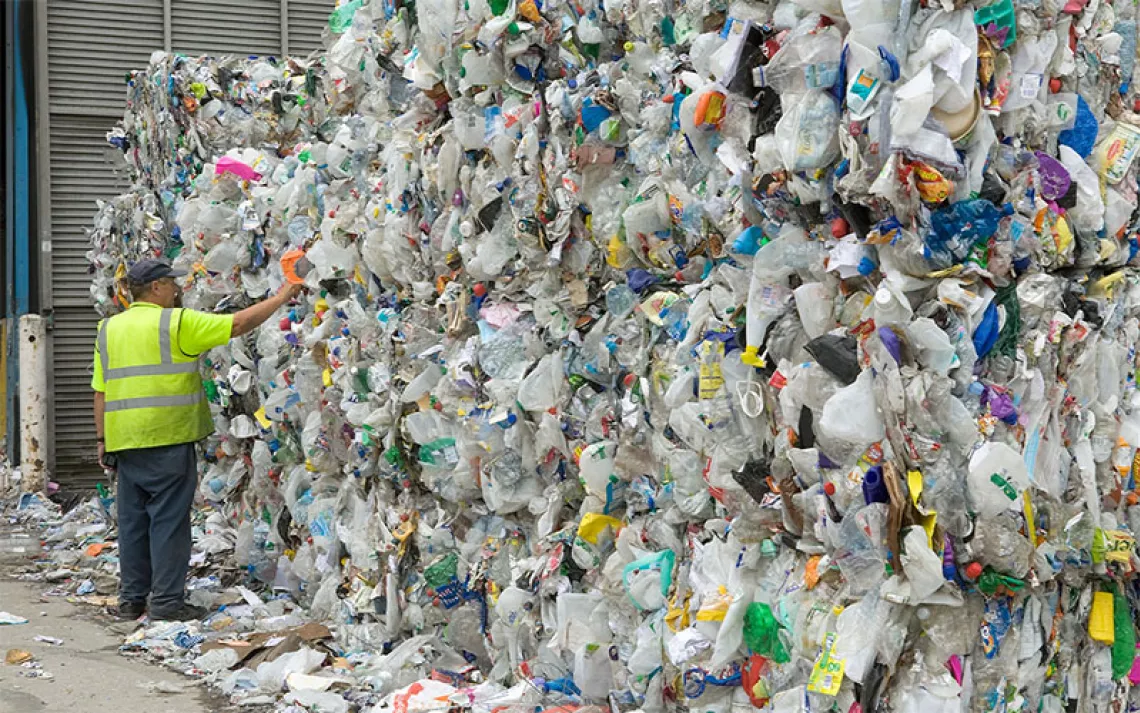These Are the New Titans of Plastic
Pennsylvania is just the latest sacrifice zone for plastics
DURING THE SUMMER OF 2018, two of the largest cranes in the world towered over the Ohio River. The bright-red monoliths were brought in by the multinational oil and gas company Shell to build an approximately 800-acre petrochemical complex in Potter Township, Pennsylvania—a community of about 500 people. In the months that followed, the construction project would require remediating a brownfield, rerouting a highway, and constructing an office building, a laboratory, a fracked-gas power plant, and a rail system for more than 3,000 freight cars.
The purpose of Shell's massive complex wasn't simply to refine gas. It was to make plastic.
Five years after construction began at the site, Shell's complex, which is one of the biggest state-of-the-art ethane cracker plants in the world, is set to open. An important component of gas and a byproduct of oil refinery operations, ethane is an odorless hydrocarbon that, when heated to an extremely high temperature to "crack" its molecules apart, produces ethylene; three reactors combine ethylene with catalysts to create polyethylene; and a 2,204-ton, 285-foot-tall "quench tower" cools down the cracked gas and removes pollutants. That final product is then turned into virgin plastic pellets. Estimates suggest that a plant the size of the Potter Township petrochemical complex would use ethane from as many as 1,000 fracking wells.
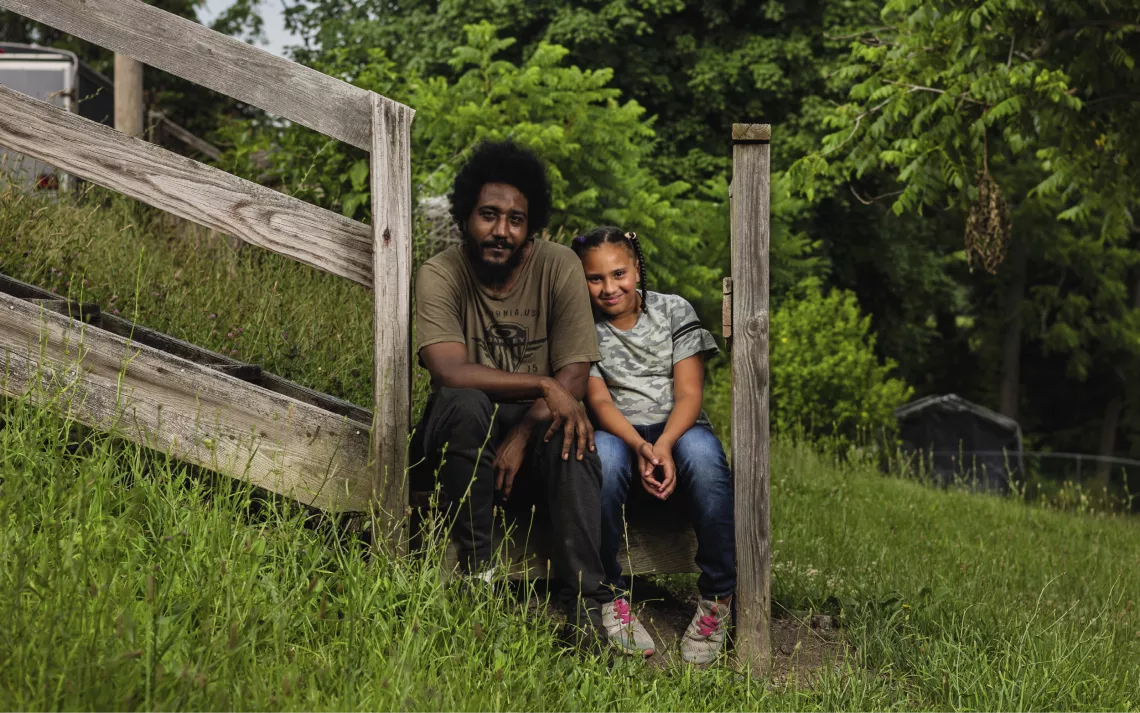
Jeff Bryant and his daughter, Cheyenne, live in Marianna, one of the most heavily fracked counties in Pennsylvania; Cheyenne tested positive for biomarkers of exposure to toxic chemicals.
Shell ranks in the top 10 among the 90 companies that are responsible for two-thirds of historic greenhouse gas emissions. Its Potter Township cracker plant is expected to emit up to 2.25 million tons of climate-warming gases annually, equivalent to approximately 430,000 extra cars on the road. It will also emit 159 tons of particulate matter pollution, 522 tons of volatile organic compounds, and more than 40 tons of other hazardous air pollutants. Exposure to these emissions is linked to brain, liver, and kidney issues; cardiovascular and respiratory disease; miscarriages and birth defects; and childhood leukemia and cancer. Some residents fear that the plant could turn the region into a sacrifice zone: a new "Cancer Alley" in Beaver County, Pennsylvania.
"I'm worried about what this means for our air, which is already very polluted, and for our drinking water," said Terrie Baumgardner, a retired English professor and a member of the Beaver County Marcellus Awareness Community, the main local advocacy group that fought the plant. Baumgardner, who is also an outreach coordinator at the Philadelphia-based nonprofit environmental advocacy group Clean Air Council, lives near the ethane cracker. In addition to sharing an airshed with the plant, she is one of the approximately 5 million people whose drinking water comes from the Ohio River watershed. When Shell initially proposed the petrochemical plant in 2012, she and other community advocates tried their best to stop it.
And the plant's negative impact will go far beyond Pennsylvania. Shell's ethane cracker relies on a dense network of fracking wells, pipelines, and storage hubs. It's one of the first US ethane crackers to be built outside the Gulf of Mexico, and one of five such facilities proposed throughout Appalachia's Ohio River Valley, which stretches through parts of Ohio, Indiana, Kentucky, Pennsylvania, and West Virginia. If the project is profitable, more like it will follow—dramatically expanding the global market for fossil fuels at a time when the planet is approaching the tipping point of the climate crisis.
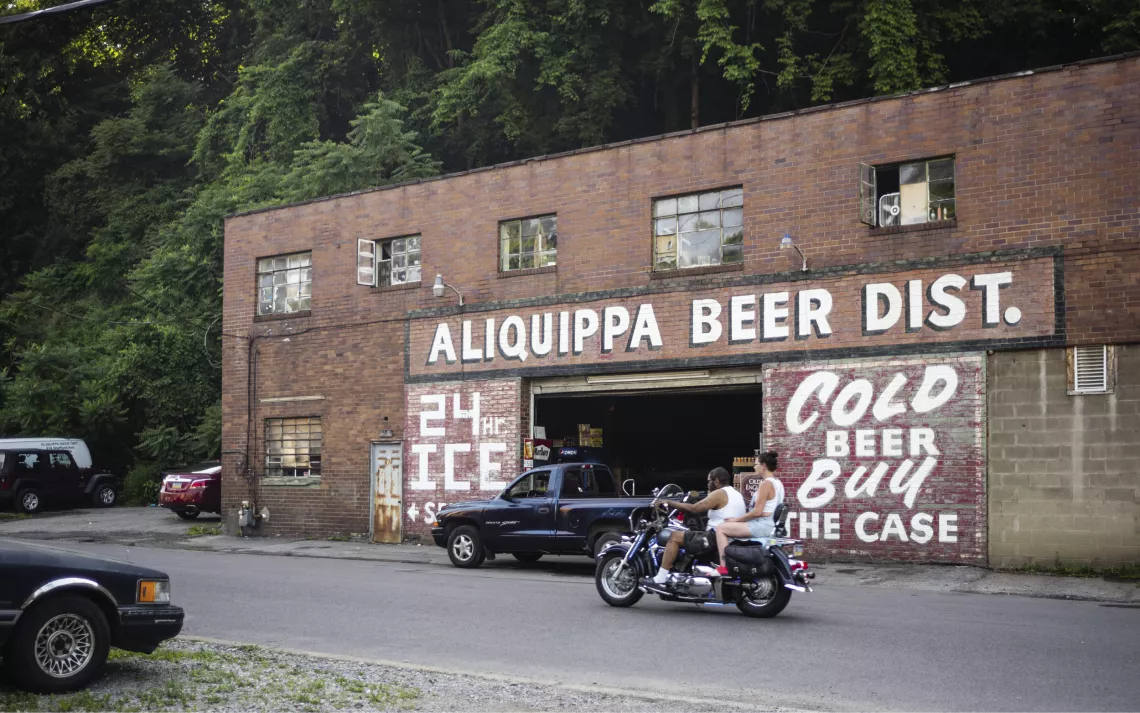
Scenes from Aliquippa, a town six miles south of the Shell plant that's likely to be affected by its pollution.
For the residents who live nearby, Shell's big bet on plastic represents a new chapter in the same story that's plagued the region for decades: An extractive industry moves in, exports natural resources at a tremendous profit—most of which flow to outsiders—and leaves poverty, pollution, and illness in its wake. First came the loggers, oil barons, and coal tycoons. Then there were the steel magnates and the fracking moguls.
Now it's the titans of plastic.
SHELL'S PETROCHEMICAL complex produces polyethylene nurdles. They are pellets, about the size of a lentil, which are used to make many consumer products, including the single-use plastic packaging and bags that contribute to the global plastic crisis. Microplastics contain a mix of harmful chemicals and have been found in virtually every corner of Earth's water and soil and in animals throughout the food web, including human bodies. Nurdles are what's known as "primary microplastics": plastics that were tiny to begin with, not broken down from larger pieces. An estimated 230,000 tons of nurdles wind up in oceans every year. They resemble tiny eggs, so fish are prone to eating them.
Aliquippa Beer Distributor in Pennsylvania.
Shell has promised that its Pennsylvania plant won't release nurdles into local waterways. "Polyethylene powder and pellets are not allowed to make their way into local waterways under any circumstances," a Shell spokesperson said in an email, pointing to the company's enrollment in a program sponsored by the American Chemistry Council and the Plastics Industry Association that aims to help plastics manufacturers achieve "zero plastic resin loss."
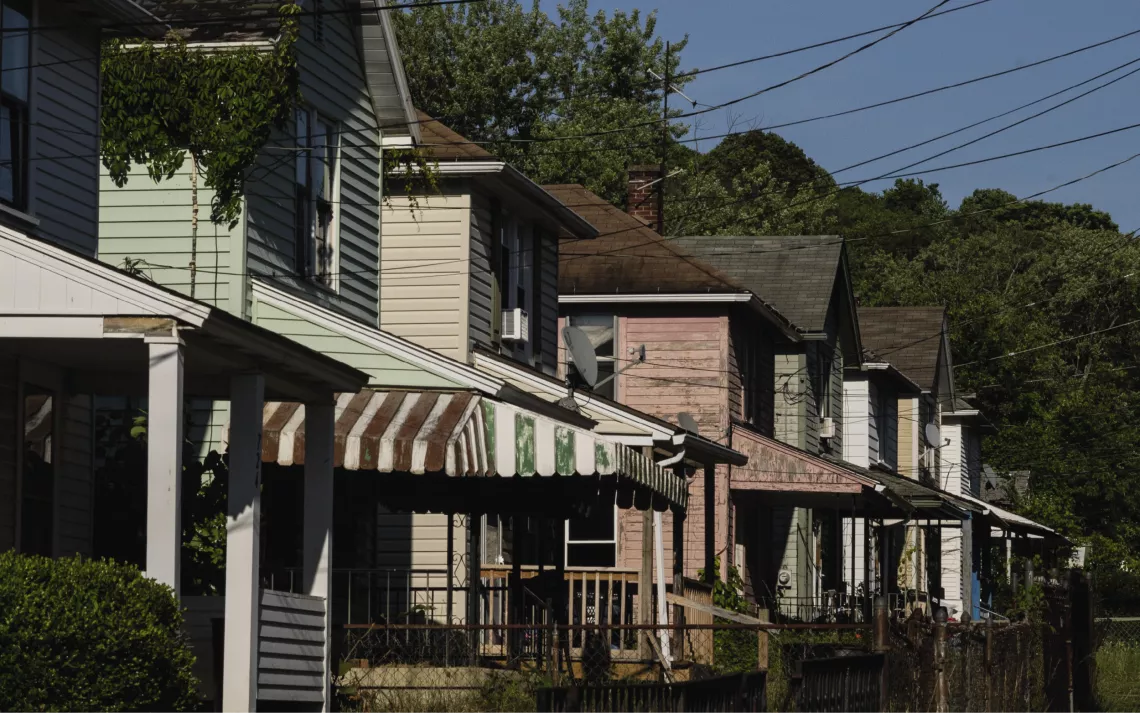
Scenes from Aliquippa, a town six miles south of the Shell plant that's likely to be affected by its pollution.
That program has been around for more than 25 years, but as of 2016, nurdles were still the second-largest source of ocean micropollutants (after tire dust). Nurdles are easily lost or swept away by the wind during transport via trucks, barges, and trains. Shipping accidents have led to vast spills. Unlike oil, nurdles aren't classified as a hazardous material, so most states don't regulate them, and federal agencies aren't obligated to clean up spills.
Many nearby residents, however, remain unconvinced by Shell's officious assurances. "Sooner or later, they're gonna have a big spill of those nurdles," said Bob Schmetzer, who cofounded the Beaver County Marcellus Awareness Community. "It's a matter of time. . . . There are nurdles in the water anywhere those plants are."
As the world increasingly turns toward renewable energy and strives to decarbonize, fossil fuel giants like Shell are trying to advance a new plastics boom to keep their ventures afloat—and it's working. Plastics manufacturing is estimated to account for more than a third of the growth in oil demand by 2030 and nearly half by 2050—ahead of trucks, aviation, and shipping, according to the International Energy Agency.
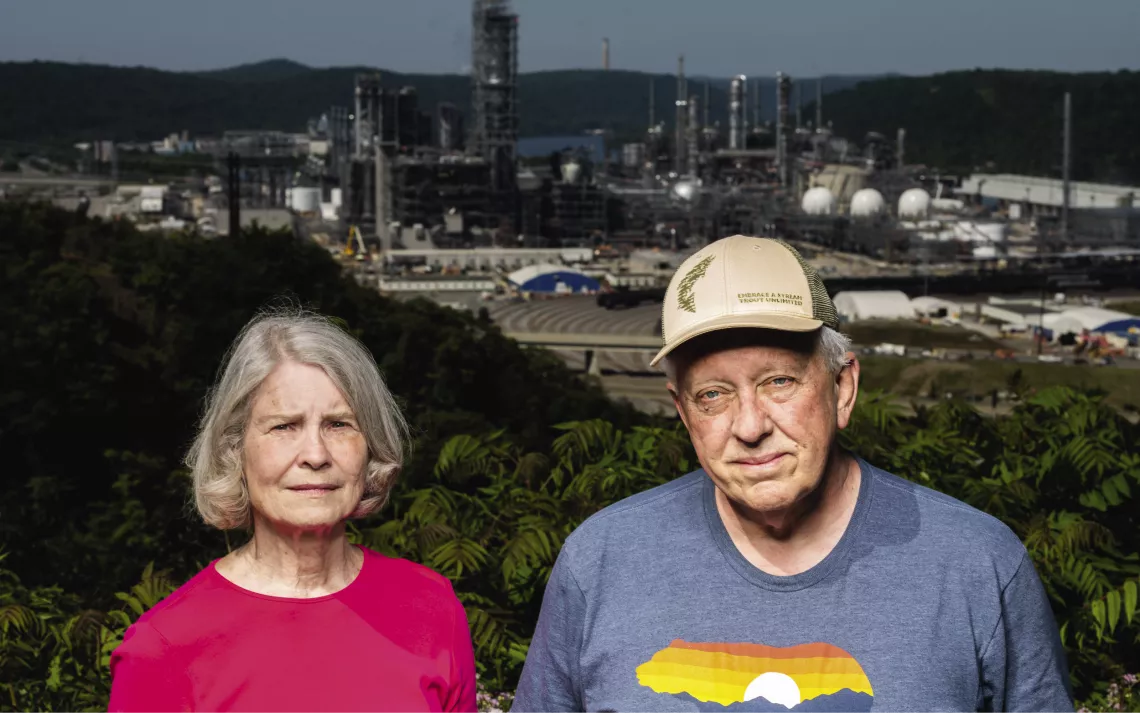
Terrie Baumgardner and Bob Schmetzer of the advocacy group Beaver County Marcellus Awareness Community.
Shell's Pennsylvania plant relies on ethane from fracking wells, a sector that has recently benefited from Russia's war on Ukraine. Prior to the war, the industry suffered from an oversupply of gas and consistently low prices, which created negative cash flows and large amounts of debt. More than 600 fracking companies and related industries in North America filed for bankruptcy between 2015 and 2022. As of 2019, Shell was one of the largest fracking leaseholders and producers over a nine-county area in the Appalachia Basin, primarily in Pennsylvania, operating more than 300 wells. The cracker plant will create additional demand from existing wells and is expected to prompt the drilling of new ones, all at a time when the war in Ukraine has caused a huge spike in gas prices and a windfall for companies like Shell.
A row of houses in Aliquippa, Pennsylvania.
It takes millions of gallons of water to frack for gas, which are typically withdrawn from local waterways or aquifers. The wastewater that comes back up to the surface contains radioactive elements and heavy metals, and it isn't always disposed of safely. Chemicals known to be dangerous to the environment and human health, such as PFAS, are also used in the process.
The plastics and fracking industries, and all the pipelines and infrastructure associated with them, are major drivers of climate change. Recent studies show that methane emissions from fracking have been drastically undercounted because these analyses don't account for leaks. Methane is about 80 times more potent than carbon dioxide at driving global warming in the short term. In 2019, global atmospheric methane reached a 20-year high, with some researchers pointing to the US fracking boom as the culprit.
Between direct emissions and methane leaks from the fracking industry, the US plastics industry emits greenhouse gases at the same rate as 116 coal-fired power plants, according to a report from the advocacy group Beyond Plastics. The same report says that if the global plastics industry were a country, it would be the world's fifth-largest greenhouse gas emitter.

Dwan B. Walker, the mayor of Aliquippa, feels that Shell didn't consider the opinions of his constituents.
"The cracker is really only here because of local natural gas and subsidies offered to Shell. Of course it's beneficial for the folks who get those jobs, but we shouldn't just look at a small set of local outcomes when considering these things."
"Even this one facility is not just one facility," Matt Mehalik, executive director of the Breathe Project, a Pittsburgh-based collaborative of more than 50 regional and national environmental advocacy groups, said of Shell's Potter Township project. "The ethane cracker itself is well down the production chain. It starts with fracking wells, then there are gathering lines, pipelines, and compressor stations, among other facilities. And after the cracker plant, there are downstream manufacturing processes to turn these plastic pellets into products. Every single part of that chain poses risks."
"You have to drill the wells to support the petrochemical plant, but you also have to build the petrochemical plant in order to keep drilling the wells," said Rebecca Scott, associate professor of environmental sociology at the University of Missouri. "It's like a Ponzi scheme for natural gas."
THE BEAVER COUNTY Marcellus Awareness Community spent years fighting an influx of fracking wells long before Shell proposed to build an ethane cracker plant nearby. Once it learned about the proposal, the community group then pivoted from opposing wells to trying to stop the ethane cracker. During the course of a seven-year campaign, it formed partnerships with local and national environmental and health advocacy groups, including the Breathe Project and its members, such as the Clean Air Council, and with researchers at local universities and water protectors from Native American tribes throughout the watershed. Together, they launched a comprehensive grassroots campaign against the cracker: They canvassed, filed petitions, appealed permit approvals, spoke at public hearings, and held protests.
The Novelty Shoppe in Marianna, Pennsylvania.
The Clean Air Council's efforts secured some concessions from Shell, including improved traffic mitigation, additional restrictions on noise and light during construction, fence-line air monitoring, and improved pollution controls during flaring (burning off excess natural gas). But in the end, they couldn't stop the plant. "None of it did any good," Baumgardner said. "In the last year, we've changed our organizing strategy. Now we're doing air monitoring, noise monitoring, light monitoring, and getting ready to watch the water for plastic nurdles."
The Beaver County Marcellus Awareness Community group launched Eyes on Shell, which provides resources like emergency planning information in case of an accident at the site; instructions on where to obtain air monitors; contact information for relevant regulatory agencies, nonprofits, and research groups; and detailed instructions on how to document and report any unusual happenings at the plant. Their vigilance proved valuable before the plant even opened.
In September 2021, members of the group and other residents noticed a sickly-sweet maple-syrup-like smell emanating from the site and notified regulatory agencies. The state Department of Environmental Protection (DEP) issued Shell violations for "malodorous air contaminants," and Shell identified the smell as coming from chlorotolyltriazole, a compound that, according to the company, formed when they applied a corrosion inhibitor and bleach to cooling units at the plant. In March 2022, a piece of faulty equipment resulted in the spill of 2,500 gallons of sulfuric acid at the site. Again, residents and activists learned of the problem when a number of them received notifications from a national alert system that there had been a sulfuric acid spill in the area. Although the alert didn't specify the origin of the spill, it didn't take much research on the part of local activists to determine that it had occurred at the cracker plant. Shell later stated that the spill was entirely contained and that none made its way into nearby water or soil, and no violations were issued.
"The plant wasn't even opened up yet, and they were already getting violations for not being able to contain these chemicals inside the fence line," Schmetzer said. "It was scary."
Living near fracking wells or related infrastructure has been linked to everything from preterm births and high-risk pregnancies to asthma, migraines, skin disorders, and anxiety. "For leukemia and lymphoma, the current understanding is that it could show up as soon as three to five years after exposure, and within less than 10 years for sure," said Dr. Cheng-Kuan Lin, a physician and former researcher at Harvard University's T.H. Chan School of Public Health. "Solid tumors like lung cancer could take 10 or 20 years. And other cancer types could take more than 30 years to show up."
Lin was the lead author on three studies examining literature on the cancer risk associated with living near petrochemical facilities. A study of leukemia found that people who live near petrochemical complexes are 36 percent more likely to develop cancer than those who don't. The risk is higher for certain types of leukemia. People living near petrochemical facilities are about 85 percent more likely to develop chronic lymphocytic leukemia compared with people not living near these facilities. The studies also found that those who live near petrochemical complexes are almost 20 percent more likely to develop lung cancer.
Terrie Baumgardner and Bob Schmetzer of the advocacy group Beaver County Marcellus Awareness Community.
Lin noted that pollutants from these types of facilities might vary from country to country, but they all emit benzene, a known risk factor for leukemia. Shell's Pennsylvania plant will emit numerous cancer-causing chemicals including benzene and formaldehyde. He also pointed out that some of the studies followed people for only a short period of time, so they likely didn't capture the whole picture. "In general, the longer you trace these populations, the more cancers you'll find," he said.
Families living among the Marcellus Shale fracking fields fear what the proliferation of wells will mean for their health. Jeff Bryant and his nine-year-old daughter, Cheyenne, live in Marianna, a tiny borough in Washington County that is located about 60 miles south of Shell's new plant and is one of the most heavily fracked counties in the state. Only 450 people live there, and 21.6 percent of them live in poverty (a rate that's substantially higher than the national poverty rate of 11.4 percent). When drilling began in 2018 at dozens of new fracking wells surrounding the town, Cheyenne, who was five at the time, developed headaches, respiratory problems, and nosebleeds. "She'd wake up in the morning with her nose bleeding, then just bleed and bleed," Bryant said.
The headaches were alarming too. Cheyenne would hold her head and cry, saying, "My head is stabbing."
In 2019, Environmental Health News tested the air, water, and urine of Pennsylvania families who lived near fracking wells for contaminants. The investigation found biomarkers for harmful chemicals in the bodies of children living near fracking wells at levels up to 90 times higher than the national average. Cheyenne's urine sample showed biomarkers indicating exposure to toluene, ethylbenzene, styrene, benzene, and other chemicals used in fracking, which are linked to respiratory, kidney, liver, circulatory, and nervous system problems; skin irritation; and increased cancer risk.
Jeff and Cheyenne Bryant.
Dwan B. Walker, the mayor of Aliquippa, feels that Shell didn't consider the opinions of his constituents.
"She's been poisoned," Bryant said. "All she does is run around outside with her friends—there's no reason these things should be in her body."
Some studies have found that emissions from fracking wells tend to be highest during the drilling phase. Cheyenne's health problems got better once drilling had been completed. But Bryant worries more wells are coming, and the family can't afford to move.
RESIDENTS OF ALLEGHENY COUNTY, which includes Pittsburgh, are about 35 miles away from Potter Township, but they could be just as impacted by Shell's cracker plant. Home to massive industrial polluters like US Steel and PPG Industries, the county had air that was among the dirtiest in the nation before Shell's ethane cracker arrived. Yet even though air and water pollution don't respect geographical borders, residents outside Potter Township were given little say about the plant.
Julie DiCenzo, a retired medical writer, joined the citizens group Communities First–Sewickley Valley because of her concerns about both the cracker plant and the fracking wells that had received permits less than a mile from her home. She started attending town meetings in neighboring Economy Borough, where some fracking wells had already received permits and the shale gas drilling company had plans for more, but as a nonresident, she wasn't permitted to speak. "Even though it's in another county, it's still affecting us," DiCenzo said.
In addition to holding public educational meetings to raise awareness about the risks from the ethane cracker and fracking, members of Communities First–Sewickley Valley worked to persuade several of the 11 municipalities in the local school district to implement zoning ordinances that would keep oil and gas development as far away from residents as possible, with mixed success. This lack of political power for residents was evident in the permitting process for the Shell ethane cracker too. Residents of the counties surrounding the site regularly packed Potter Township's community meetings about the plant, but some felt that their opinions didn't count because they weren't residents of the township itself.

Make every day an Earth Day
Get articles like this one sent directly to your inbox.
With this action you affirm you want to receive Sierra Club communications and may vote on policy designated by the Sierra Club Board.
The plastics plant has also raised concerns about environmental justice. Beaver County is 91 percent white, with a median household income of $59,000 a year and 9 percent of the people living below the poverty line. But within 15 miles of Shell's plant, there are at least eight communities where residents are more than 30 percent non-white or more than 20 percent of people live in poverty. In Aliquippa, about six miles south of the plant, around 41 percent of the town's approximately 9,200 residents are non-white and a third are Black. The median annual income is $36,451, and a quarter of its residents live below the poverty line.
When the plant was proposed, the promises to nearby residents were big: a 25-year operating contract, other new businesses in the region, and up to 20,000 direct and indirect jobs. But some Aliquippa residents say those promises remain unfulfilled. "The city hasn't seen much benefit from the plant so far," said Dwan B. Walker, who has served as Aliquippa's mayor for 11 years. Being mayor of Aliquippa is a labor of love—Walker makes just $175 a month doing the job and works for a security company to pay the bills. He decided to run for mayor after his sister was shot and killed in 2009 because he wanted to make his community safer.
Walker, too, went to Shell's public hearings about the plant but didn't feel that his opinion or the opinions of his constituents mattered. He still hopes the plant might eventually create downstream manufacturing jobs for the residents of Aliquippa, but he also worries about his community's and his own family's health.
In 2021, following President Joe Biden's executive order on environmental justice, Pennsylvania governor Tom Wolf formally established the Environmental Justice Advisory Board and the Environmental Justice Interagency Council. As it stands, Pennsylvania's current policy states that environmental justice communities (defined as including "historically and currently low-income communities and communities of color") should get extra consideration to review permits for polluting facilities. Aliquippa's proximity to the plant means its air will be significantly impacted by emissions, but the town didn't get such special consideration during the permitting phase. Nor did any of the other environmental justice communities nearby.
"It's a weak policy," said Joe Minott, the executive director and chief counsel for the Clean Air Council. Minott has criticized the DEP for declining to follow its existing environmental justice policies. "It contains very few specifics about how to actually achieve environmental justice, and it's just a policy right now, not backed up by any regulations, so they're not even obligated to follow it."
In 2014, Minott's group created a detailed report on the expected impacts of the ethane cracker, including increased risk of cancer and respiratory and heart disease, increased traffic, and light and noise pollution. The organization also provided expert witnesses and legal counsel to the community, then took Shell to court. Shell eventually settled on both counts and agreed to provide better pollution controls during flaring and continuous fence-line air monitoring at the plant, accompanied by a public online dashboard where residents can review air-monitoring data.
Walker said residents of Aliquippa have also had concerns about fracking well proposals nearby. "The DEP didn't hold any meetings with me or the city council to talk about environmental concerns," he said. "We'd need to have a lot more conversations about that before we let it happen here. I don't want to be in the grocery store hearing, 'You let them do what?'"
IN AN ATTEMPT TO LURE SHELL to Pennsylvania, the state's former Republican governor Tom Corbett approved legislation offering Shell an "unlimited tax credit" in 2012, one year after he slashed $1 billion in public education funding. It was one of the largest subsidy packages ever awarded to a company in the United States. Of the 183 state legislators who voted on the bill, just 62 voted against it.
That windfall hasn't translated into growth for Beaver County. A study by the Ohio River Valley Institute, a nonprofit progressive research organization, concluded that during construction of the plant, Beaver County actually fell behind both the state and the nation in nearly every measure of economic activity. The county's population has continued to decline, all while registering "zero growth in employment, zero reduction in poverty, and zero growth in businesses—even when factoring in all the temporary construction workers at this site."
Other research promises that those benefits are still coming. A study commissioned by Shell and published by researchers at Robert Morris University in 2021 projected that once it opened, the ethane cracker would add nearly $4 billion a year to the state's economy. In Beaver County alone, the report found, the complex would produce $260 million to $846 million in annual economic activity, including wages, benefits, and related spending. Environmental advocates called the report "propaganda" because it didn't consider subsidies or externalized costs to health and the environment. The true costs and benefits remain to be seen.
It's difficult to quantify the public health costs of a facility like the ethane cracker, but modeling tools offer a rough idea. According to predictions from the EPA's CO-Benefits Risk Assessment tool, the plant's emissions of PM2.5—toxic airborne particulate much tinier than the width of a human hair—are estimated to cost Beaver County an additional $16 million a year in health-care costs. That's not counting other pollutants like volatile organic compounds and hazardous chemicals. Neighboring Allegheny County can expect about $13 million in additional health-care costs. The national health-care burden is expected to increase by about $70 million a year from pollution that travels from Shell's plant beyond the area. A DEP spokesperson said that estimating potential health-care costs associated with emissions for a proposed facility is not part of the state's permitting process.
Republican state senator Elder Vogel Jr., one of the sponsors of the $1.7 billion subsidy the state offered Shell, represents parts of Pennsylvania's Beaver, Lawrence, and Butler Counties, including Potter Township, where the cracker plant is located. Despite the local opposition, he remains a firm supporter of the facility. "All across the world, people have heard about Beaver County now," Vogel said. "This Shell plant is putting us on the map."
When asked whether state legislators considered the public health costs before offering Shell $1.7 billion in tax subsidies, Vogel said, "No, not really. I don't believe so."
Nick Muller, a professor of economics, engineering, and public policy at Carnegie Mellon University, coauthored a 2019 study on the environmental and employment impacts of the shale gas boom. It found that the adverse effects on public health almost exactly equaled the economic benefits, and the climate costs subtracted another $12 billion to $15 billion in value, putting the industry's cumulative economic impact in the red. "The cracker is really only here because of local natural gas and subsidies offered to Shell," Muller said. "Of course it's beneficial for the folks who get those jobs, but we shouldn't just look at a small set of local outcomes when considering these things."
WHEN HAVING AN ABUNDANCE of natural resources either doesn't translate into sustainable wealth or leaves a region more impoverished than it started, sociologists refer to it as "the resource curse."
In Appalachia, examples of the resource curse abound, according to the University of Missouri's Rebecca Scott. "Appalachia has been culturally marginalized by narratives of backwardness and welfare dependency, like the image of the hillbilly in popular culture," Scott said. Those harmful stereotypes can make residents more eager to belong in ways that are seen as culturally important, like contributing to the production of energy or essential materials like steel and plastic. "It becomes not only about the community's ability to have commodities but also its ability to belong, and for its members to have a sense of personal worth."
This context helps explain why for some Western Pennsylvanians, the Shell plant felt like a godsend. "The Shell construction project put everybody in the unionized construction industry in Beaver County, Allegheny County, and Butler County to work, and then, because of the magnitude of the job, they started pulling in people from farther away," said Larry Nelson, president of the Beaver County Building and Construction Trades.
Nelson's organization, which is one of several local chapters of North America's Building Trades Unions, represents about 20 local construction unions including plumbers, plasterers, painters, sheet metal workers, boilermakers, operating engineers, cement masons, and bricklayers. "Before that job started, just about all the trades had some form of unemployment," Nelson said. "It helped the unions out greatly."
Union members receive the same pay and benefits as others in their same profession, regardless of the type of job they're working on or which client they're working for, Nelson said. But the Shell project stood out as being one of the safest job sites he's ever seen. "Workers had something called 'work stop authority,' which gives any worker the ability to stand up and say, 'Wait, something doesn't look safe. Let's pause and take another look,'" he said. Nelson believes the plant could be a continuing source of employment and that Shell will call on the unions for future projects at the plant as needed.
Shell officials have made numerous efforts to demonstrate that the company makes a good neighbor. Shell gave $1 million to the Community College of Beaver County to develop a training program for petrochemical facility workers and has hired at least 13 graduates to fill permanent roles at the plant, according to a company spokesman. The company created a community advisory panel and hosts a quarterly virtual community meeting. During the pandemic, Shell donated money and services to local food banks and charitable organizations, donated hand sanitizer to local schools, donated N95 masks and nitrile gloves to local hospitals, and sponsored an employee donation drive for the Beaver County Humane Society.
"The community has benefited from the first day they started moving dirt down at the facility," Vogel said. In addition to the jobs at the plant, the state senator pointed to the indirect jobs it has created, including those in the new hotels, restaurants, and facilities serving the influx of construction workers from out of town, and in the catering and shuttle services for employees at the site. "One of my neighbors is retired, but he got a job driving workers in from the off-site parking lots a few hours a week," Vogel said. "Another neighbor up over the hill from me went to Shell's new training program at the community college and got hired. He's 21 or 22, and he'll have a lifetime career there if he wants it."
The political climate in Pennsylvania's state government is aggressively pro-oil, pro-gas, and pro-industry. That's driven in part by the Republican-controlled legislature, but Governor Wolf and other state Democrats have also supported the Shell project.
State representative Sara Innamorato, who represents parts of Pittsburgh, is one of the few Democrats who opposed the plant. "They say 'jobs, jobs, jobs,' but a lot of legislators stop there in their critical thinking about the benefits of this kind of tax package," she said. "We aren't doing the math to figure out this is costing us millions of tax dollars per job. We're foregoing billions of dollars of revenue over the life of this plant at a time when we can't afford to make necessary investments in our infrastructure, our public schools, or our small businesses."
BOB SCHMETZER SPENT NEARLY four decades working as an electrician with the local union. He supports good jobs for union workers. For him, Shell's promises ring hollow.
"I lived through the era when the steel mills all shut down at one time," he said. "I'm afraid we're facing that again now. What happens when you take 8,000 temporary workers and they all leave or they're all out of work again?"
For people like Schmetzer, who are living in the shadow of the cracker but not directly benefiting from the jobs, the trade-offs are obvious. His wife died from heart disease a few years ago, which he attributes in part to air pollution from the oil and gas industry and the proliferation of fracking wells. "She already had heart problems, so it wasn't like air pollution originated it, but it kicked it into gear, and I'm still furious about that," he said.
Following his wife's death, Schmetzer's sister, who lived nearby, fled the region when a fracking well went in about a mile from her house. She moved to North Carolina to get away from the well. "I don't get to see my sister anymore," he said. "I'm sure someone else would feel the same way if these things happened to their families."
Many others, like Jeff and Cheyenne Bryant, can't afford to move away. For the Bryant family, the stakes of Shell's big bet on plastic couldn't be higher—for Cheyenne in particular. "Twenty years of research on this fracking thing has already proven that it's bad for our health," Bryant said. "But they're still putting in more and more wells that are killing us. It isn't right."
This story was produced in partnership with Environmental Health News.
This article appeared in the Fall 2022 quarterly edition with the headline "The Titans of Plastic."
 The Magazine of The Sierra Club
The Magazine of The Sierra Club


